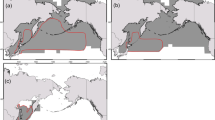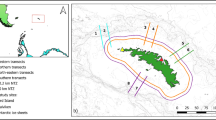Abstract
Understanding the dynamics of open marine populations is inherently complex, and this complexity has led to decades of debate regarding the relative importance of pre- versus post-settlement processes in structuring these populations. Movement between patches may be an important modifier of patterns established at settlement, yet local immigration and emigration have received less attention than other demographic rates. I examined loss rates from tagged populations of juvenile wrasses (yellowhead wrasse Halichoeres garnoti and bluehead wrasse Thalassoma bifasciatum) at two sites in the Bahamas. Assuming that all losses were due solely to mortality would have significantly underestimated survivorship of yellowhead wrasse by 29% and bluehead wrasse by 14%. On average, per capita mortality and emigration rates were higher for yellowhead than bluehead wrasse, but neither demographic rate differed between sites for either species. With respect to within-species density, bluehead wrasse mortality was density-dependent at the patch reef site, but mortality rates of yellowhead wrasse were consistently density-independent. Evaluating the effects of between-species density, yellowhead wrasse mortality increased with a decrease in bluehead wrasse density, but this effect was limited to the patch reef site. Emigration rates were not a function of either within-species or between-species density, but instead varied inversely with isolation distance. Numerous previous studies of coral-reef fish, conducted on patch reefs separated by only a few meters of sand and often using untagged fish, may have confounded losses due to emigration with those due to mortality. A better understanding of the factors affecting emigration in marine fishes is important to their effective management using spatial tools such as marine protected areas.




Similar content being viewed by others
References
Ault TR, Johnson CR (1998) Spatially and temporally predictable fish communities on coral reefs. Ecol Monogr 68:25–50
Beukers J, Jones GP (1997) Habitat complexity modifies the impact of piscivores on a coral reef fish population. Oecologia 114:50–59
Beukers JS, Jones GP, Buckley RM (1995) Use of implant microtags for studies on populations of small reef fish. Mar Ecol Prog Ser 125:61–66
Bohlke JE, Chaplin CCG (1993) Fishes of the Bahamas and adjacent tropical waters. Univeristy of Texas Press, Austin
Booth DJ (1995) Juvenile groups in a coral reef damselfish: density-dependent effects on individual fitness and population demography. Ecology 76:91–106
Caley MJ, Carr MH, Hixon MA, Hughes TP, Jones GP, Menge BA (1996) Recruitment and the local dynamics of open marine populations. Ann Rev Ecol Syst 27:477–500
Carr MH, Hixon MA (1995) Predation effects on early post-settlement survivorship of coral reef fishes. Mar Ecol Prog Ser 124:31–42
Carr MA, Anderson TA, Hixon MA (2002) Biodiversity, population regulation, and the stability of coral-reef fish communities. Proc Natl Acad Sci USA 99:11241–11245
Caselle JE (1997) Small-scale spatial variation in early life history characteristics of a coral reef fish: implications for dispersal hypotheses. In: Proceedings of 8th International Coral Reef Symposium 2:1161–1166
Caselle JE (1999) Early post-settlement mortality in a coral reef fish and its effects on local population size. Ecol Monogr 69:177–194
Connell SD (1996) Variations in mortality of a coral-reef fish—links with predator abundance. Mar Biol 126:347–352
Connell SD (1997) The relationship between large predatory fish and recruitment and mortality of juvenile coral reef fish on artificial reefs. J Exp Mar Biol Ecol 209:261–278
Connell SD (1998) Effects of predators on growth, mortality, and abundance of a juvenile reef fish: evidence from manipulations of predator and prey abundance. Mar Ecol Prog Ser 169:251–261
Connell SD (2000) Is there safety in numbers for prey? Oikos 88:527–532
Doherty PJ (1982) Some effects of density on the juveniles of two species of tropical, territorial damselfishes. J Exp Mar Biol Ecol 65:249–261
Doherty PJ (1987) The replenishment of populations of coral reef fishes, recruitment surveys, and the problems of variability manifest on multiple scales. Bull Mar Sci 41:411–422
Doherty PJ (2002) Variable replenishment and the dynamics of reef fish populations. In: Sale PF (ed) Coral reef fishes: dynamics and diversity in a complex ecosystem. Academic, San Diego, pp 327–355
Forrester GE, Vance RR, Steele MA (2002) Simulating large-scale population dynamics using small-scale data. In: Sale PF (ed) Coral reef fishes: dynamics and diversity in a complex ecosystem. Academic, San Diego, pp 275–301
Frederick JL (1997) Post-settlement movement of coral reef fishes and bias in survival estimates. Mar Ecol Prog Ser 150:65–74
Fretwell SD, Lucas HJ (1969) On territorial behavior and other factors influencing habitat distribution in birds. Acta Biotheor 19:16–36
Hixon MA (1991) Predation as a process structuring coral reef fish communities. In: Sale PF (ed) The ecology of fishes on coral reefs. Academic, San Diego, pp 475–508
Hixon MA (1998) Population dynamics of coral-reef fishes: controversial concepts and hypotheses. Aust J Ecol 23:192–201
Hixon MA, Beets JP (1993) Predation, prey refuges, and the structure of coral reef fish assemblages. Ecol Monogr 63:77–101
Hixon MA, Carr MH (1997) Synergistic predation, density dependence, and population regulation in marine fish. Science 277:949–949
Hixon MA, Webster MS (2002) Density dependence in reef fish populations. In: Sale PF (ed) Coral reef fishes: dynamics and diversity in a complex ecosystem. Academic, San Diego, pp 303–325
Hixon MA, Pacala SW, Sandin SA (2002) Population regulation: historical context and contemporary challenges of open vs. closed systems. Ecology 83:1490–1508
Houston AI, McNamara JM (1997) Patch choice and population size. Evol Ecol 11:703–722
Levin PS, Tolimieri N, Nicklin M, Sale PF (2000) Integrating individual behavior and population ecology: the potential for habitat-dependent population regulation in a reef fish. Behav Ecol 5:565–571
Lewis AR (1997) Recruitment and post-recruit immigration affect the local population size of coral reef fishes. Coral Reefs 16:139–149
Losey GS (1974) Cleaning symbiosis in Puerto Rico with comparison to the tropical Pacific. Copeia 1974:960–970
Martha K, Jones M (2002) Behavioural overlap in six Caribbean labrid species: intra- and interspecific similarities. Environ Biol Fish 65:71–81
Murdoch WW (1969) Switching in general predators: experiments on predator specificity and stability of prey populations. Ecol Monogr 39:335–354
Murdoch WW, Avery S, Smyth MEB (1975) Switching in predatory fish. Ecology 56:1094–1105
Nemeth RS (1998) The effect of natural variation in substrate architecture on the survival of juvenile bicolor damselfish. Environ Biol Fish 53:129–141
Osenberg CW, St. Mary CM, Schmitt RJ, Holbrook SJ, Chesson P, Byrne B (2002) Rethinking ecological inference: density dependence in reef fishes. Ecol Lett 5:715–721
Overholtzer-McLeod KL (2003) Population dynamics of coral-reef fishes: spatial variation in emigration, mortality, and predation. Dissertation. Oregon State University
Overholtzer-McLeod KL (2004) Variance in reef spatial structure masks density dependence in coral-reef fish populations on natural versus artificial reefs. Mar Ecol Prog Ser 276:269–280
Planes S, Lecaillon G (2001) Caging experiment to examine mortality, during metamorphosis of coral reef fish larvae. Coral Reefs 20:211–218
Robertson DR (1988) Abundances of surgeonfishes on patch-reefs in Caribbean Panama: due to settlement or post-settlement events? Mar Biol 97:495–501
Robertson DR (1996) Interspecific competition controls abundance and habitat use of territorial Caribbean damselfishes. Ecology 77:885–899
Sale PF (1991) Introduction. In: Sale PF (ed) The ecology of fishes on coral reefs. Academic Press, San Diego California, pp 3–15
Sale PF, Tolimieri N (2000) Density dependence at some time and place? Oecologia 124:166–171
Sale PF, Douglas WA, Doherty PJ (1984) Choice of microhabitats by coral reef fishes at settlement. Coral Reefs 3:91–99
Schmitt RJ, Holbrook SJ (1996) Local-scale patterns of larval settlement in a planktivorous damselfish—do they predict recruitment? Mar Freshw Res 47:449–463
Schmitt RJ, Holbrook SJ (1999) Mortality of juvenile damselfish: implications for assessing the processes that determine abundance. Ecology 80:35–50
Schmitt RJ, Holbrook SJ, Osenberg CW (1999) Quantifying the effects of multiple processes on local abundance: a cohort approach for open populations. Ecol Lett 2:294–303
Shima JS (1999) Variability in relative importance of determinants of fish recruitment. Ecol Lett 2:304–310
Shima JS (2001) Regulation of local populations of coral reef fish via joint effects of density- and number-dependent mortality. Oecologia 126:58–65
Sih A, Wooster D (1994) Prey behavior, prey dispersal, and predator impacts on stream prey. Ecology 75:1199–1207
Sponaugle S, Cowen RK (1997) Early life history traits and recruitment patterns of Caribbean wrasses (Labridae). Ecol Monogr 67:177–202
Steele MA (1997) The relative importance of processes affecting recruitment of two temperate reef fishes. Ecology 78:129–145
Steele MA, Forrester GE (2002) Early postsettlement predation on three reef fishes: effects of spatial patterns of recruitment. Ecology 83:1076–1091
Stewart BD, Jones GP (2001) Associations between the abundance of piscivorous fishes and their prey on coral reefs: implications for prey-fish mortality. Mar Biol 138:383–397
Tupper M, Hunte W (1994) Recruitment dynamics of coral reef fishes in Barbados. Mar Ecol Prog Ser 108:225–235
Victor BC (1982) Daily otolith increments and recruitment in two coral-reef wrasses, Thalassoma bifasciatum and Halichoeres bivittatus. Mar Biol 71:203–208
Webster MS (2002) Role of predators in the early post-settlement demography of coral-reef fishes. Oecologia 131:52–60
Webster MS (2003) Temporal density dependence and population regulation in a marine fish. Ecology 84:623–628
Webster MS, Almany GR (2002) Positive indirect effects in a coral reef fish community. Ecol Lett 5:549–557
Wilson J, Osenberg CW (2002) Experimental and observational patterns of density-dependent settlement and survival in the marine fish Gobiosoma. Oecologia 130:205–215
Acknowledgements
For outstanding assistance underwater, I thank A. Altieri, C. Bartels, D. Booth, M. Dean, B. McLeod, D. Pakes, and especially B. Byrne. The staff of the Caribbean Marine Research Center provided excellent logistical assistance. Comments from G. Jones, B. McLeod, P. Sale, C. Stallings, M. Webster, and an anonymous reviewer significantly improved the manuscript. This is a chapter from my dissertation, which benefited from reviews by my doctoral committee: M. Hixon (chair), M. Blouin, D. Markle, B. Menge, and S. Sogard. Financial support was provided to the author by Zoology Research Funds from Oregon State University, and NSF grant (OCE-96-17483) and NOAA-NURP grant (CMRC-97-3109) to M. Hixon. Additional support for manuscript preparation was provided to the author by COMPASS (Communication Partnership for Science and the Sea).
Author information
Authors and Affiliations
Corresponding author
Additional information
Communicated by Ecological Editor P.F. Sale
Rights and permissions
About this article
Cite this article
Overholtzer-McLeod, K.L. Post-settlement emigration affects mortality estimates for two Bahamian wrasses. Coral Reefs 24, 283–291 (2005). https://doi.org/10.1007/s00338-005-0477-3
Received:
Accepted:
Published:
Issue Date:
DOI: https://doi.org/10.1007/s00338-005-0477-3




